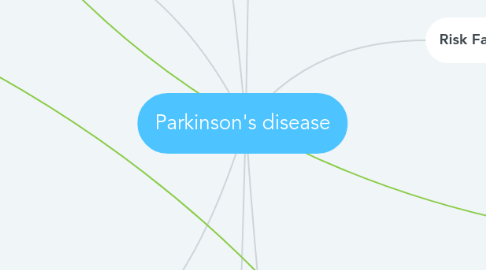
1. Incidence/Prevelence (statistics about occurrence)
1.1. occurs in 1% of the population over the age of 60
1.2. Juvenile Parkinsonism is associated in people younger than 40 who have Wilson's disease, progressive lenticular degeneration, or Huntington's Disease.
1.3. Affects men slightly more than women
1.4. Higher incidence in people of Hispanic/Latino and White/European ancestry
2. Diagnosis (including labs and other testing, both for screening and diagnosis)
2.1. Positron emission tomography and single photon emission computed tomography
2.1.1. test for low levels of dopamine in the brain
2.2. MRI
2.2.1. test for signs of stroke or brain tumor
2.3. CT scan
2.3.1. tests for signs of stroke or brain tumor
2.4. Blood tests
2.4.1. test for abnormal thyroid hormone levels or liver damage
3. Clinical Manifestations (signs and symptoms)
3.1. gradually slowing of voluntary movement (bradykinesia)
3.2. muscle rigidity
3.2.1. legs
3.2.2. face
3.2.3. neck
3.2.4. jaw
3.3. stooped posture
3.4. distinctive gait
3.4.1. short, accelerating steps
3.4.2. head forward
3.5. diminished facial expression
3.5.1. difficulty swallowing
3.5.1.1. choking
3.5.1.2. drooling
3.5.1.3. coughing
3.5.2. difficulty speaking (soft and monotoned)
3.6. resting tumor
4. References
4.1. Nursing Bound
4.2. Clarke, C. E. (2013). Parkinson’s disease. BMJ : British Medical Journal, 335(7617), 441–445.
4.3. Ayano G (2016) Parkinson's Disease: A Concise Overview of Etiology, Epidemiology, Diagnosis, Comorbidity and Management. J Neurol Disord 4: 298.
5. Pathogenesis (how does it occur)
5.1. caused by degeneration of the substantial nigra in the basal ganglia of the midbrain
5.1.1. leads to depletion of the neurotransmitter dopamine (DA)
5.1.1.1. leads to impairment of the extrapyramidal tracts and consequential loss of movement coordination
5.2. Primary (idiopathic)
5.2.1. unknown
5.3. Secondary (iatrogenic)
5.3.1. drug or chemical related
5.3.1.1. dopamine-depleting drugs
5.3.1.2. reserpine
5.3.1.3. phenothiazine
5.3.1.4. metoclopramide
5.3.1.5. tetrabenazine
5.3.1.6. butyrophenones
6. Risk Factors (who gets it)
6.1. Autosomal dominant or recessive forms of the disease
6.1.1. Genetic loci (PARK 1-9)
6.2. Mutations of additional genes
6.2.1. HTRA2
6.2.2. LRRK2
6.2.3. NR4A2
6.2.4. NDUFV2
6.2.5. ADH3
6.2.6. FGF20
6.2.7. GBA
6.2.8. MAPT
6.3. long term exposure
6.3.1. chemicals
6.3.2. pesticides
6.3.3. well-water
6.4. Age
6.4.1. older than 60 years old
7. Treatments (including medications)
7.1. Antiparkinson
7.1.1. Levodopa (L-dopa)
7.1.2. Carbidopa levodopa (Sinemet)
7.2. Amantadine hydrochloride
7.3. Synthetic anticholinergics
7.3.1. trihexyphenidyl (Artane)
7.3.2. benxtropine mesylate (Cogentin)
7.4. Antihistamines
7.5. Bromocriptine mesylate
7.6. MAO-B inhibitors
7.6.1. rasagiline
7.6.2. selegiline
7.7. Apomorphine
7.8. Electroconvulsive Therapy
7.8.1. improves movement for short period of time
7.8.2. depression that does not respond to drugs may be improved
7.9. Brain surgery
7.9.1. Deep brain stimulation
7.9.2. Pallidotomy
7.9.3. Thalamotomy
